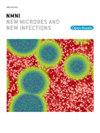Tunnel sign on magnetic resonance imaging in neuromelioidosis: A systematic literature review
IF 5.4
Q2 INFECTIOUS DISEASES
引用次数: 0
Abstract
Background
Neuromelioidosis can present with abscesses, meningitis, or encephalomyelitis, but can be missed on blood culture. Linear enhancement of the corticospinal tract (white matter motor pathway) on magnetic resonance imaging (MRI) in the form of a ‘tunnel sign’ is an essential clue for early diagnosis of neuromelioidosis. This systematic review (SR) explores the clinical profile and outcomes of neuromelioidosis patients with tunnel signs.
Methods
An SR was conducted to look for articles reporting individual details of neuromelioidosis patients with tunnel signs (reported or present on published images) on MRI. This review followed PRISMA guidelines and was prospectively registered with PROSPERO (CRD42024597199). After title-abstract and full-text screening, clinical profile and outcome data were extracted and analysed.
Results
Thirty cases (22 articles) with tunnel signs on MRI were included after screening 2985 articles. The traditional risk factors (diabetes mellitus, alcohol intake, steroids, etc.) for melioidosis were present in only 23 % (5/22) of patients. Limb weakness (89 %, 24/27) and cranial nerve involvement (46 %, 11/24) were commonly seen at presentation. Blood and cerebrospinal fluid (CSF) cultures for B.pseudomallei were only positive in 15 % (2/13) and 22 % (4/18). Due to low rates of clinical suspicion of neuromelioidosis (25 %, 6/24), empirical steroids and inappropriate antimicrobials were given in 47 % (8/17) and 65 % (9/17) of patients, respectively. A total of 30 % (n = 9) of the patients died.
Conclusion
In melioidosis-endemic areas with access to MRI, recognising the link between the presence of a tunnel sign and neuromelioidosis is crucial to initiate early adequate therapy.
神经类瘤病磁共振成像隧道征:系统文献综述
背景:类神经瘤病可表现为脓肿、脑膜炎或脑脊髓炎,但可在血培养中被遗漏。磁共振成像(MRI)上皮质脊髓束(白质运动通路)以“隧道征”的形式线性增强是早期诊断类神经瘤病的重要线索。本系统综述(SR)探讨了具有隧道征象的神经类鼻疽患者的临床特征和预后。方法对MRI上报道有隧道征象(已报道或已发表图像)的类神经瘤病患者的个体细节进行回顾性分析。本综述遵循PRISMA指南,并在PROSPERO进行前瞻性注册(CRD42024597199)。在标题摘要和全文筛选后,提取临床资料和结果数据并进行分析。结果经2985篇文献筛选,共纳入MRI隧道征30例(22篇)。类鼻疽的传统危险因素(糖尿病、饮酒、类固醇等)仅在23%(5/22)的患者中存在。肢体无力(89%,24/27)和脑神经受累(46%,11/24)常见于首发。血液和脑脊液(CSF)培养阳性的分别为15%(2/13)和22%(4/18)。由于临床对类神经瘤病的怀疑率较低(25%,6/24),47%(8/17)和65%(9/17)的患者分别给予经验性类固醇和不适当的抗菌药物治疗。共有30% (n = 9)的患者死亡。结论:在类鼻疽病流行区,通过MRI检查,认识到隧道征象与类鼻疽病之间的联系对于及早开始适当的治疗至关重要。
本文章由计算机程序翻译,如有差异,请以英文原文为准。
求助全文
约1分钟内获得全文
求助全文
来源期刊

New Microbes and New Infections
Medicine-Infectious Diseases
CiteScore
10.00
自引率
2.50%
发文量
91
审稿时长
114 days
 求助内容:
求助内容: 应助结果提醒方式:
应助结果提醒方式:


